
Squirrels are members of the family Sciuridae, a family that includes small or medium-size rodents. The squirrel family includes tree squirrels, ground squirrels, chipmunks, marmots, flying squirrels, and prairie dogs amongst other rodents. Squirrels are indigenous to the Americas, Eurasia, and Africa, and were introduced by humans to Australia. The earliest known fossilized squirrels date from the Eocene epoch, and among other living rodent families, the squirrels are most closely related to the mountain beaver and to the dormice.
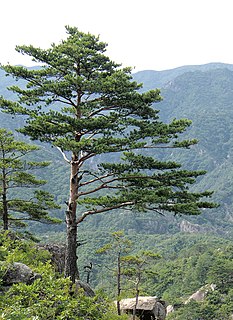
A pine is any conifer in the genus Pinus of the family Pinaceae. Pinus is the sole genus in the subfamily Pinoideae. The Plant List compiled by the Royal Botanic Gardens, Kew and Missouri Botanical Garden accepts 126 species names of pines as current, together with 35 unresolved species and many more synonyms. Pine may also refer to the lumber derived from pine trees; pine is one of the more extensively used types of wood used as lumber.
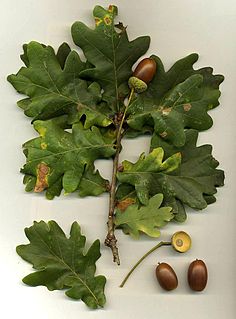
An oak is a tree or shrub in the genus Quercus of the beech family, Fagaceae. There are approximately 500 extant species of oaks. The common name "oak" also appears in the names of species in related genera, notably Lithocarpus, as well as in those of unrelated species such as Grevillea robusta and the Casuarinaceae (she-oaks). The genus Quercus is native to the Northern Hemisphere, and includes deciduous and evergreen species extending from cool temperate to tropical latitudes in the Americas, Asia, Europe, and North Africa. North America contains the largest number of oak species, with approximately 90 occurring in the United States, while Mexico has 160 species of which 109 are endemic. The second greatest center of oak diversity is China, which contains approximately 100 species.

Mahogany is a straight-grained, reddish-brown timber of three tropical hardwood species of the genus Swietenia, indigenous to the Americas and part of the pantropical chinaberry family, Meliaceae.

Eucalyptus is a genus of over seven hundred species of flowering trees, shrubs or mallees in the myrtle family, Myrtaceae. Along with several other genera in the tribe Eucalypteae, including Corymbia, they are commonly known as eucalypts. Plants in the genus Eucalyptus have bark that is either smooth, fibrous, hard or stringy, leaves with oil glands, and sepals and petals that are fused to form a "cap" or operculum over the stamens. The fruit is a woody capsule commonly referred to as a "gumnut".

Liriodendron is a genus of two species of characteristically large trees, deciduous over most of their populations, in the magnolia family (Magnoliaceae).
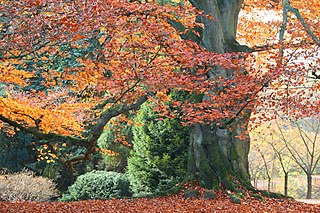
Beech (Fagus) is a genus of deciduous trees in the family Fagaceae, native to temperate Europe, Asia, and North America. Recent classifications recognize 10 to 13 species in two distinct subgenera, Engleriana and Fagus. The Engleriana subgenus is found only in East Asia, distinctive for their low branches, often made up of several major trunks with yellowish bark. The better known Fagus subgenus beeches are high-branching with tall, stout trunks and smooth silver-grey bark. The European beech is the most commonly cultivated.

Platanus is a genus consisting of a small number of tree species native to the Northern Hemisphere. They are the sole living members of the family Platanaceae.
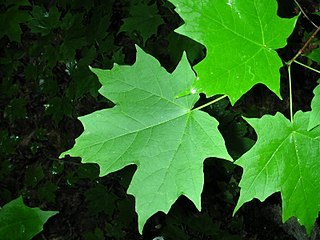
Acer saccharum, the sugar maple, is a species of flowering plant in the soapberry and lychee family Sapindaceae. It is native to the hardwood forests of eastern Canada, from Nova Scotia west through southern Quebec, central and southern Ontario to southeastern Manitoba around Lake of the Woods, and northcentral and northeastern United States, from Minnesota eastward to Maine and southward to northern Virginia, Tennessee and Missouri. Sugar maple is best known for being the primary source of maple syrup and for its brightly colored fall foliage. It may also be known as "rock maple", "sugar tree", "birds-eye maple", "sweet maple", "curly maple", or "hard maple", particularly when referring to the wood.

Yucca brevifolia is a plant species belonging to the genus Yucca. It is tree-like in habit, which is reflected in its common names: Joshua tree, yucca palm, tree yucca, and palm tree yucca.

A savanna or savannah is a mixed woodland-grassland ecosystem characterised by the trees being sufficiently widely spaced so that the canopy does not close. The open canopy allows sufficient light to reach the ground to support an unbroken herbaceous layer consisting primarily of grasses.

The flowering plant family Lauraceae, the laurels, includes the true laurel and its closest relatives. This family comprises about 2850 known species in about 45 genera worldwide. They are dicotyledons, and occur mainly in warm temperate and tropical regions, especially Southeast Asia and South America. Many are aromatic evergreen trees or shrubs, but some, such as Sassafras, are deciduous, or include both deciduous and evergreen trees and shrubs, especially in tropical and temperate climates. The genus Cassytha is unique in the Lauraceae in that its members are parasitic vines.

Tilia is a genus of about 30 species of trees or bushes, native throughout most of the temperate Northern Hemisphere. The tree is known as linden for the European species, and basswood for North American species. In Britain and Ireland they are commonly called lime trees or lime bushes, although they are not closely related to the tree that produces the lime fruit. The genus occurs in Europe and eastern North America, but the greatest species diversity is found in Asia. Under the Cronquist classification system, this genus was placed in the family Tiliaceae, but genetic research summarised by the Angiosperm Phylogeny Group has resulted in the incorporation of this genus, and of most of the previous family, into the Malvaceae.

Tocorimé Pamatojari is a Brazilian tall ship. Her name means 'The Adventurous Spirit of the number Fourteen', in the native tongue of the Kulina people of the Brazilian Amazon. The name is a tribute to the number 14 and a famous footballer Johan Cruijff,.

Itaubal is a municipality located in the southeast of the state of Amapá in Brazil. Its population is 5,617 and its area is 1,704 square kilometres (658 sq mi). Itaubal is located 112 kilometres (70 mi) from the state capitol of Macapá. It takes its name from the itaúba, a valuable species of laurel. The tree was once found in great abundance in the region, but is now endangered. Itaubal is bordered to the southeast by the delta of the Amazon River, and surrounded by Macapá to the southwest, west, and north.

Mezilaurus is a genus of plant in the family Lauraceae. It is a neotropical genus consisting of 18-27 species, mostly hardwood evergreen trees, occurring from Costa Rica to the southeast of Brazil. 13 species have been identified in Brazil, distributed mostly in the Amazon region. In Rio de Janeiro state only M. navalium (Allemão) Taub. ex Mez has been recorded. Some species have been reported within the Cerrado and in semideciduous forest surrounding the Pantanal Matogrossense. The name Mezilaurus refers to its similar appearance to the genus Laurus.
Mezilaurus navalium is a species of plant in the family Lauraceae. It is endemic to Brazil.

In botany, a tree is a perennial plant with an elongated stem, or trunk, supporting branches and leaves in most species. In some usages, the definition of a tree may be narrower, including only woody plants with secondary growth, plants that are usable as lumber or plants above a specified height. In wider definitions, the taller palms, tree ferns, bananas, and bamboos are also trees. Trees are not a taxonomic group but include a variety of plant species that have independently evolved a trunk and branches as a way to tower above other plants to compete for sunlight. Trees tend to be long-lived, some reaching several thousand years old. Trees have been in existence for 370 million years. It is estimated that there are some three trillion mature trees in the world.

The Tapajós National Forest is a Brazilian national forest in the state of Pará, Brazil. It supports sustainable exploitation of the natural resources in an area of Amazon rainforest.
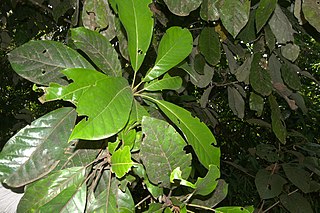
Williamodendron is a genus of evergreen trees belonging to the Laurel family, Lauraceae, in South America.



















